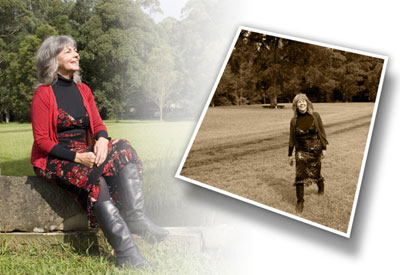This year the Seed Savers’ Network held their conference in rural Gulgong, near Mudgee, a world apart from Byron Bay, where Seed Savers is based.
Gulgong, the town on the $10 note, is quaint, and so was the event. Set in and around the tin sheds of the Gulgong Showground generously catered for by the ladies and gentlemen of the Gulgong Show Society, the pace was relaxed.
That didn’t prevent many stimulating topics, like genetically modified foods or climate change farming, and ideas thereon, from sparking up the delegates. Seed Savers do a great job on many levels — have a look at their website.

The local Seed Savers branch organised it so some speakers were local, like Mike and Sue Pridmore, who collect and sell native tree seeds.

Sue also makes beautiful baskets from just about anything that once grew. As Mike is also an ex-potter and renowned mud home builder, you could say they are truly in touch with the earth.
But the unique part of this conference was the Saturday night entertainment, when the Mayor, and then his old mate in the cowboy hat, recited or sang their own and other’s ditties — unaccompanied. Henry Lawson would have been impressed.





 Early in March I went to the Coolah Tops National Park for the first time. Averaging 1100 metres, they offer what would be stunning views over the Liverpool and Breeza Plains—if the Hunter coalmines’ dust haze hadn’t got that far. But I’d actually come for the Coolah Tops Jazz Festival.
Early in March I went to the Coolah Tops National Park for the first time. Averaging 1100 metres, they offer what would be stunning views over the Liverpool and Breeza Plains—if the Hunter coalmines’ dust haze hadn’t got that far. But I’d actually come for the Coolah Tops Jazz Festival.
 Before the music began I did note that each ridge top was of loose basalt rocks, that screes on mountainsides were common, and that certain freestanding rocks were glaring rather balefully at the tourists snapping them.
Before the music began I did note that each ridge top was of loose basalt rocks, that screes on mountainsides were common, and that certain freestanding rocks were glaring rather balefully at the tourists snapping them.
 Apart from the many Eastern red-necked wallabies, I share my place with small groups of other hoppy marsupials.
Apart from the many Eastern red-necked wallabies, I share my place with small groups of other hoppy marsupials.






 Robert and Gail Bignell are friends, originally met when I interviewed Robert for an Owner Builder magazine story about his charming handmade bush cabin.
Robert and Gail Bignell are friends, originally met when I interviewed Robert for an Owner Builder magazine story about his charming handmade bush cabin.
